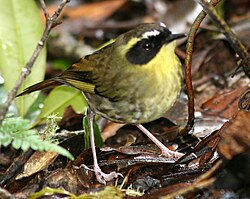Yellow-throated scrubwren
| Yellow-throated scrubwren | |
|---|---|
 |
|
| Scientific classification | |
| Kingdom: | Animalia |
| Phylum: | Chordata |
| Class: | Aves |
| Order: | Passeriformes |
| Family: | Acanthizidae |
| Genus: | Sericornis |
| Species: | S. citreogularis |
| Binomial name | |
|
Sericornis citreogularis (Gould, 1838) |
|
The yellow-throated scrubwren (Sericornis citreogularis) is a passerine bird found in parts of eastern coastal Australia. Placed in the family Pardalotidae in the Sibley-Ahlquist taxonomy, this has met with opposition and indeed is now known to be wrong; they rather belong to the independent family Acanthizidae.
A small ground-dwelling bird that inhabits wet forest or rainforest, it is insectivorous. The bird has a distinctive yellow throat and eyebrow. The male face is black and the female brown. The crown and upperparts are dark- to olive-brown, and the underparts cream, white or washed-out olive. The wings are dark brown and edged with yellow. Breeding twice or more in a long breeding season, it nests in large suspended pear-shaped structures. Often over water, they resemble flood debris which they are often placed nearby. These nests are the preferred roosts of the golden-tipped bat (Phoniscus papuensis).
The yellow-throated scrubwren was originally described by ornithologist John Gould in 1838. The specific epithet citreogularis derived from the Latin terms cǐtreus "pertaining to citrus" and gǔla "throat", hence "yellow throated". The northern subspecies cairnsii was described by amateur ornithologist Gregory Mathews in 1912.
The yellow-throated scrubwren measures 12.5–15 cm (5–6 in) in length. The male bird has a black masked face and ear coverts, with yellow throat and eyebrow. The iris is reddish and upperparts brownish and underparts paler. The wing primaries are yellow and relatively long legs pinkish or cream. The female has a brownish face. Calls include a loud harsh chatter, and a lively song, the latter can be a response to a loud noise such as a car door slamming.
The species is found in two disjunct distributions; in coastal north Queensland from Cooktown to Townsville, and from Hervey Bay in southern coastal Queensland south through to southeastern New South Wales. The usual habitat is rainforest gullies, generally with streams nearby. In the Sydney Basin this may be the Illawarra escarpment, and wetter places in the Dharug- and Royal National Parks.
...
Wikipedia

